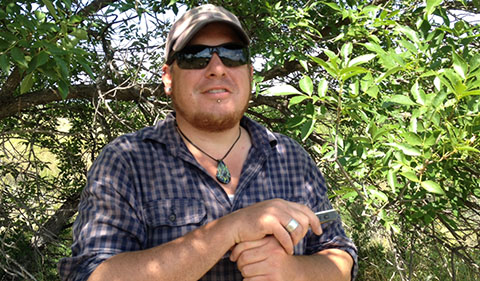
Philip Bauschard
“I am privileged to have a career that allows me to get paid for doing what I love,” says Philip Bauschard ’07, an archaeological field and lab director at The Mannik & Smith Group, Inc., in Maumee, Ohio, with a specialty in lithic analysis. He is also a member of the Ohio Archaeological Council.
Since graduating with a B.A. in Anthropology with a minor in Geography from the College of Arts & Sciences at Ohio University and completion of Dr. Elliot Abrams’ OHIO Archaeology Field School, he worked as a field technician on a project-to-project basis across the United States Upper Midwest, Appalachia, Southeast, and Northern Plains until entering the master’s program in Saint Cloud, after which he began working on a supervisory level.
“I am a cultural resource management archaeologist working in the private sector as a consultant to clients with development projects that involve funds or permits that trigger their legal obligation to take into consideration their project’s potential effects on cultural resources,” Bauschard says.
“My primary responsibilities include supervising field crews conducting archaeological investigations, processing artifacts for analysis, analyzing prehistoric artifact assemblages, contributing material for technical reports submitted to state and federal agencies, and presenting archaeological findings to public audiences.”
He is scheduled to defend his master’s thesis at Saint Cloud State University in Minnesota in spring 2017 to complete the Cultural Resource Management Archaeology M.S. program.
“My Ohio University experience led me to the career I have today,” Bauschard adds. “Dr. AnnCorinne Freter-Abrams initially caught my interest in anthropology with her introductory course to archaeology and from there I quickly made anthropology my undergraduate major and found myself taking courses that I recognize now as having instilled in me familiarity and comfort with critical thinking, research, and ethical practice.
“Archaeology is after all a discipline within the umbrella of anthropology, and the combination of cultural and archaeological courses I followed at Ohio University rounded my understanding of and approach to studying human lifeways in the distant past,” Bauschard says.
“Dr. Nancy Tatarek’s forensics class was my initial experience with human remains and when I eventually encountered them in the field in my career in North Dakota, I was reminded of how she taught us to treat the deceased with respect.
“As a result of her teaching I was able to recognize human bone and also told my treatment of the burial was appropriate by tribal representatives. Grad school was a big part of this, but she was the first.
“The same goes with my cultural resource management law specific knowledge. Abrams introduced me to a publication that my future grad adviser would also have me read. Lastly, then Abrams’ grad student Warren Brooks ’92 launched my career with my first paying project (after Field School) over winter break while finishing my B.A.,” Bauschard adds.
“Dr. Diane Ciekawy in particular helped me develop skills in tackling abstract concepts within cultural contexts. Dr. Haley Duschinski (in her first year at OHIO!) was instrumental in fostering ethical practices in human studies, while Abrams’ field school was perhaps the most directly applicable experience as it taught me the technical skills required for archaeological investigations. This skill set was a prerequisite for my career as a field technician immediately following my graduation. Fellow students were also instrumental to my development,” he says.
“Dr. Paul Patton, then a graduate student and assistant at Dr. Abrams’ field school, was influential in reinforcing and helping other undergraduate students practice what we were being taught.
“There were many more influential people I was privileged to study under and experiences as an OHIO student I remember fondly that also catalyzed my love of learning and practical application of learned skills; too many to mention.
“I enjoy a career that takes me outdoors and allows me to discover the physical remains of past cultures. I particularly enjoy my time in the laboratory identifying prehistoric stone tools and debitage (stone tool manufacture debris) and applying mathematical analyses to characterize and compare assemblages within or between sites,” he says.
“I believe firmly in the great value of public archaeology and appreciate working for a company that allows me to present findings when possible at public events such as Ohio Archaeology Day at The Ohio History Connection Museum in Columbus.”



















Comments